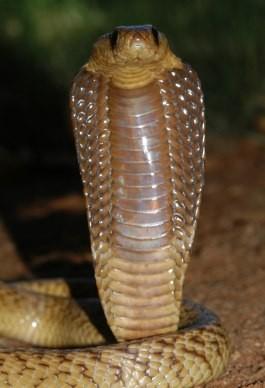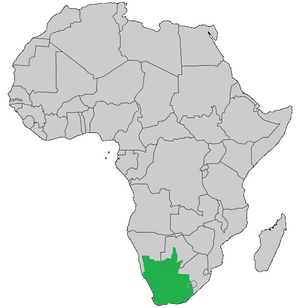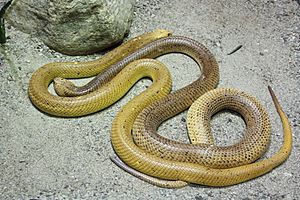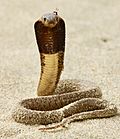Cape cobra facts for kids
Quick facts for kids Cape cobra |
|
|---|---|
 |
|
| Scientific classification | |
| Genus: |
Naja
|
| Species: |
nivea
|
 |
|
| Cape cobra distribution in green | |
| Synonyms | |
|
Coluber niveus Linnaeus, 1758 |
|
The Cape cobra (Naja nivea), also known as the yellow cobra, is a medium-sized snake. It is very venomous. This cobra lives in many different natural areas across southern Africa. These areas include dry savannas, fynbos (a type of plant life), and deserts.
The Cape cobra is active during the day. It eats many different kinds of food, including dead animals. Its predators include birds of prey, honey badgers, and mongooses. In South Africa, people also call it "geelslang" (yellow snake) or "bruinkapel" (brown cobra). Some even call it "koperkapel" (copper cobra) because of its rich yellow color. This snake has no known subspecies.
Contents
About the Cape Cobra
The Cape cobra is a medium-sized snake. Adult snakes are usually about 1.2 to 1.4 meters (4 to 4.6 feet) long. Some can grow up to 1.6 meters (5.2 feet). The longest one ever recorded was 1.88 meters (6.2 feet) long.
Cape cobras come in many colors. They can be yellow, golden brown, dark brown, or even black. Some have black or pale spots. Even though colors often depend on where the snake lives, you can find almost all colors in one place. For example, in the Kalahari Desert, they are usually more yellow. But in places like De Hoop Nature Reserve, you can see all the different colors.
Young Cape cobras have dark throats that fade as they get older. This dark throat can sometimes make people confuse them with the Rinkhals snake.
Where They Live
The Cape cobra is found only in southern Africa. In South Africa, it lives in many provinces like the Western Cape and Northern Cape. It also lives in southern Namibia, southwestern Botswana, and western Lesotho.
Even though the Cape cobra lives in a smaller area than other African cobras, it can be found in many different places. It likes fynbos, bushveld, dry savannas, and the Namib desert. They often hide in holes made by rodents, old termite mounds, or rock cracks. In dry areas, they are often found near rivers.
In Lesotho, they can live high up in the mountains, about 2,500 meters (8,200 feet) above sea level. They also live in forests and grasslands. Cape cobras sometimes go into villages and even houses. They do this to escape the heat or to find food like rodents. This means they can come into contact with people.
How They Live
The Cape cobra is active during the day. It hunts for food all day long. When it's very hot, it might hunt during dawn or dusk. It mostly stays on the ground but can climb trees and bushes. They are very good at stealing eggs from bird nests, like those of the sociable weaver.
When not hunting, they hide in holes or under piles of brush. They often stay in the same hiding spot for a while. Cape cobras are fast and alert. If they feel threatened, they will strike quickly. When they are defensive, they lift their front body, spread a wide hood, and might hiss loudly. If the danger stays still, the snake will try to escape. But if there is any movement, it will get ready to strike again. They are more aggressive when it's mating season.
What They Eat

This cobra eats many different things. Its diet includes other snakes, rodents, lizards, birds, and even dead animals. A study showed that their diet included rodents (31%), other snakes (20%), lizards (11%), birds (11%), and dead animals (16%). They are also known for raiding the nests of sociable weaver birds. Cape cobras can also eat their own young.
Who Eats Them
The honey badger is a predator of the Cape cobra. Other meat-eating mammals like meerkats and different types of mongoose also hunt Cape cobras. These animals are not as affected by the cobra's venom. Various birds of prey, such as secretary birds and snake eagles, also hunt them. Some other snake species might also eat them.
How They Reproduce
Cape cobras lay eggs. The mating season is in September and October. During this time, the snakes might be more aggressive.
Females lay between 8 and 20 eggs in mid-summer (December to January). They lay them in a hole, an old termite mound, or another warm, wet place. The baby snakes hatch measuring about 34 to 40 centimeters (13 to 16 inches) long. They are completely independent from the moment they hatch.
Cape Cobra Venom
The Cape cobra is considered one of the most dangerous cobras in Africa. This is because its venom is very powerful and it often lives near houses. The venom is thick and looks like shiny, pale flakes when it dries.
The Cape cobra's venom has strong toxins that affect the body. These toxins can harm the respiratory system (how you breathe), the nervous system (how your brain and body communicate), and the heart.
See also
 In Spanish: Cobra del Cabo para niños
In Spanish: Cobra del Cabo para niños




